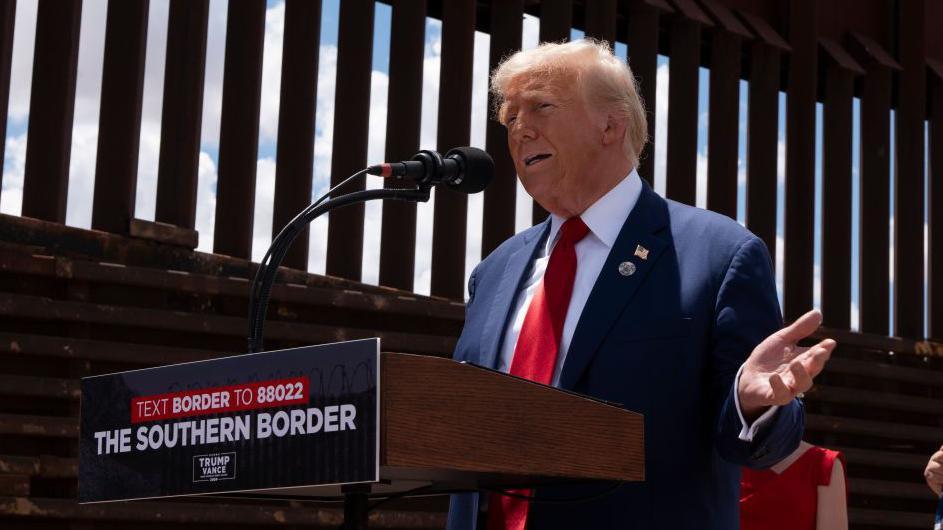What is the Insurrection Act?

- Published
On his first day back in the White House, President Donald Trump signed an executive order declaring an emergency at the US southern border and directed his top officials to evaluate whether to invoke a rarely used 19th Century law to respond to that emergency.
The Insurrection Act of 1807 allows the president to use active-duty military personnel to perform law-enforcement duties inside the US.
Trump said on Monday said he would consider using the act if federal courts prevented him from deploying the National Guard to conduct law enforcement missions and protect federal buildings.
Here's what to know.
What is the Insurrection Act of 1807?
The 19th Century law would allow the use of active-duty military personnel to perform law-enforcement duties within the US.
US presidents can invoke the law if they determine that "unlawful obstructions, combinations, or assemblages, or rebellion" against the government make it "impracticable to enforce" US law "by the ordinary course of judicial proceedings".
Once invoked, troops could be tasked with a range of duties, from quelling civil unrest and enforcing court orders to arresting and detaining migrants. This includes the National Guard - a branch of the US armed forces traditionally reserved for domestic emergencies and disasters.
Because the Insurrection Act was written in broad terms, with little specific guidance on how and when the powers can be used, it gives presidents wide latitude in deciding when to mobilise military personnel for domestic operations.
Why does Trump want to use it?
Throughout his election campaign, Trump vowed to crack down on illegal immigration, calling the southern border situation a "national emergency" that could be better tamed by invoking the 19th Century statute.
On his first day in office in January, he asked for "recommendations regarding additional actions that may be necessary to obtain complete operational control of the southern border, including whether to invoke the Insurrection Act of 1807".
The administration has already rolled out a series of sweeping measures targeting the border. These include a nationwide deportation sweep and transferring alleged Venezuelan gang members to a prison in El Salvador - a decision now facing legal challenges.
This comes as migrant apprehensions by US Border Patrol have plummeted to 6,300 in the last four months - lower than the monthly average during the Biden administration.
In October, Trump again said he was mulling the use of the Insurrection Act after a federal judge blocked him from sending National Guard troops to Portland, Oregon, which the president argues is overrun by left-wing "domestic terrorists".
While he said he had not reached a point where that decision was necessary, "if I had to enact it, I'd do it, if people were being killed and courts were holding us up, or governors and mayors were holding us up".
The same day, White House deputy chief of staff Stephen Miller said that the government was facing a "legal insurrection" and that court rulings against its law enforcement efforts were tantamount to "an insurrection against the laws and Constitution of the United States".
Watch: President Donald Trump signs first executive orders in arena
How has it been used in the past?
The Insurrection Act has been invoked a handful of times in American history.
Abraham Lincoln used it when the southern states rebelled during the US Civil War, and former President Ulysses S Grant invoked it against a wave of racist violence by the Ku Klux Klan after the war.
In the 20th Century, former President Dwight D Eisenhower invoked it so the US Army would escort black students into their high school in Little Rock, Arkansas, after the state's governor refused to comply with a federal desegregation order.
More recently, it was used in 1992 when massive riots broke out in Los Angeles over the acquittal of four white police officers in the beating of Rodney King, a black man. Then-President George Bush sent in active-duty members of the Marines and Army as well as National Guard troops.
Are there any limits on the law?
The US government has traditionally worked to limit the use of military force on American soil, especially against its own citizens.
The Posse Comitatus Act of 1878 was enacted to restrict the military from acting as domestic law enforcement. In times of unrest, states typically deploy the National Guard themselves to help maintain order.
Since returning to office, Trump has expanded his authority by declaring national emergencies - which gives the president access to powers and resources that are normally restricted.
He has used this authority to impose tariffs and, more controversially, to take action on immigration and deploy federal officers, the National Guard and even active-duty troops to cities including Washington DC, Los Angeles and Memphis.
In March, following his emergency declaration at the border, Trump invoked the rarely used Alien Enemies Act of 1798 to deport migrants he alleged were gang members. In April, the Supreme Court temporarily blocked that effort.
If Trump chooses to invoke the Insurrection Act, it remains unclear what legal challenges he might face.